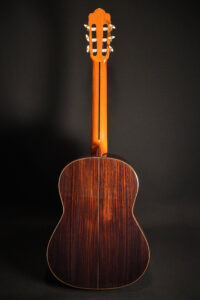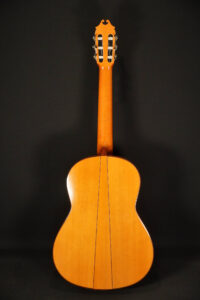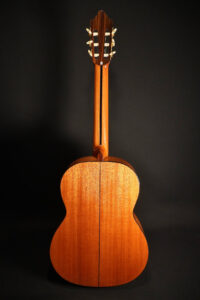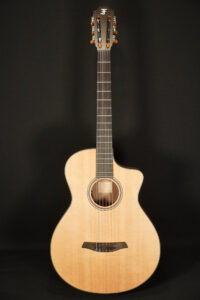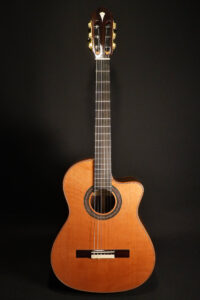Buy Classical Guitar at a glance
A Classical Guitar is generally a guitar that is strung with nylon strings. Classical Guitars are sometimes also referred to as Spanish guitars or classical guitars. Classical Guitars are available in different sizes from ¼ to size 7/8 and 4/4, so there is a suitable model for children or young guitar beginners of almost every age and body size. In addition to the different sizes available, classical guitars are also very suitable for beginners due to their nylon strings, as nylon strings are somewhat softer to the touch than steel strings and therefore easier to play for beginners.
We at Munich Guitar Company have specialized in acoustic guitars and Classical Guitars for over 30 years. That’s why we can offer you a carefully selected range of Classical Guitars that includes everything from high-end beginner instruments to guitars for professionals and rare collectors pieces.
As luthiers, we make sure that every guitar receives a professional setup before it is being sold. Any guitar can also be individually adjusted to each players personal needs.
We also offer a two-year warranty on new instruments purchased in our store.
Here you can check out our large selection of high-quality Classical Guitars:
https://guitars.de/produkt-kategorie/klassische-gitarre/
Buying a Classical Guitar for beginners – What is important?
As luthiers, we know what is important when making a guitar and what you should look for in a high quality guitar. That’s why you’ll only find instruments in our collection (including the beginners level guitars) that meet our quality standards.
A Classical Guitar for beginners should definitely have a solid Top. This makes the instrument sound better and is simply more fun to play. All solid Classical Guitars sound even better of course, but they also cost a little more.
You should also make sure that a Classical Guitar is well set up and adjusted to the player in terms of playability and string action. Well-adjusted guitars are easier to play and make learning easier, especially for beginners.
You should also pay attention to high-quality tuners and the overall quality in general.
Our experienced team can give you the perfect advice and help you find the right Classical Guitar.
We always have a large selection of Classical Guitars for beginners from manufacturers such as La Mancha, Maravilla, Valdez or Duke in stock:
https://guitars.de/klassische-gitarre/la-mancha-klassische-gitarre/
Classical Guitars for advanced and professional players
Of course, you will also find a very good selection of handmade and high-quality Classical Guitars for advanced and professional players in our collection.
We have instruments from manufacturers such as Felipe Conde, Manuel Adalid, Juan Hernandez, Esteve, Sanchis, Quiles, Jellinghaus, Romero Creations, La Canada and more.
Of course, we are also happy to make a Classical Guitar for you according to your personal wishes as a custom instrument.
When choosing the right Classical Guitar for advanced and professional players, it all depends on the desired sound, the desired feel and the area of use. Of course, there is no right or wrong here. However, if possible, you should take the time to visit a store and compare different instruments directly. Every instrument is unique, no two pieces of wood are the same, so you have to play an instrument and hear it compared to others to be able to make a good decision. At least we think so.
Classical Guitar for young beginners, children and teenagers – Which size is the right one?
Classical Guitars are available in the sizes 1/8, ¼, ½, ¾, 7/8 and 4/4.
Depending on the size of the Classical Guitar, the body of the instrument is smaller or larger and the scale length of the guitar is shorter or longer.
The right size depends on your height and the size of your hands. If the body and nut width/neck width of the Classical Guitar is too big, it will be uncomfortable and demotivating when learning. If the shape of the body and the saddle are too small, it can also be uncomfortable.
You will find guides for this, which in our opinion can be used as a rough guide, but they are often not really helpful in the end. You should therefore seek professional advice in a store to find the right size Classical Guitar.
Classical Guitar & nut width
Compared to acoustic guitars or steel-string guitars, the nut on Classical Guitars is wider. In the standard size of a Classical Guitar, the nut width is usually between 50mm and 52mm. With more modern designs of Classical Guitar, such as so-called crossover classical guitars, the nut width is sometimes 46mm, 48mm or narrower. This makes it easier for untrained fingers to play. Guitarists who normally play more acoustic or electric guitars also often prefer Classical Guitars with a slightly narrower nut width.
Here you will find various concert guitar models and sizes with different nut widths, so there is something for everyone.
Classical Guitars with cutaway
As with acoustic guitars, there are also Classical Guitars with and without a cutaway.
A cutaway is a cut-out in the body that makes it easier to reach the higher notes when playing. Classical Guitars are traditionally built without a cutaway. However, due to the growing popularity of Classical Guitars with a cutaway, you can now find many different models of this type from manufacturers such as Furch, Maravilla, Duke, Felipe Conde and others.
Classical Guitars with a cutaway are often fitted with a pickup ex works. This is due to the fact that these instruments are often used on stage or in the studio. The built-in pickup makes it easier to record the guitar.
Here you will find a selection of the Classical Guitars with cutaway currently available from us:
Classical Guitar – Tone Woods
Spruce or cedar wood is usually used for the top of a Classical Guitar. Rosewood or mahogany is very often used for the back and sides of the instrument. For flamenco guitars, a spruce Top is traditionally combined with cypress wood. These instruments are then called “Blanca” in the classic Spanish style. However, there are also flamenco guitars with rosewood back and sides. These instruments are then referred to as “negra”.
Of course, many other types of wood are used in the construction of Classical Guitars, such as ovangkol, padouk or maple. In addition to the types of wood used, the quality of the wood also plays a very importand role in the sound of a Classical Guitar. Solidly built instruments always sound fuller and more balanced than guitars that are not solidly built.
When it comes to finding a new Classical Guitar, we think the best way is to compare different wood combinations directly and let the great tonal variety of the woods inspire you. In the end, your ear will decide which is the right choice for you.




